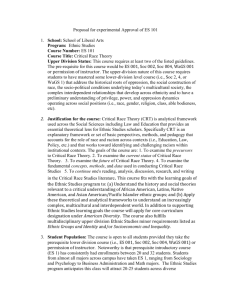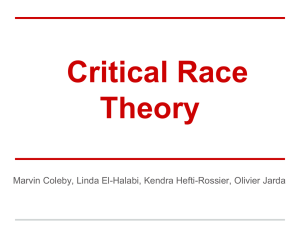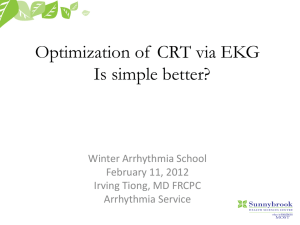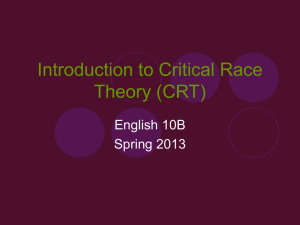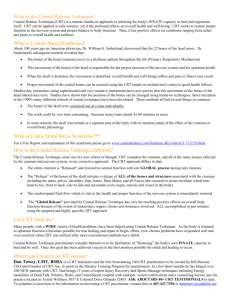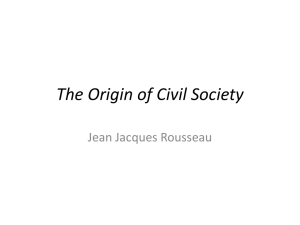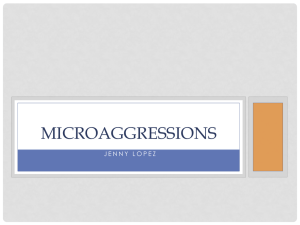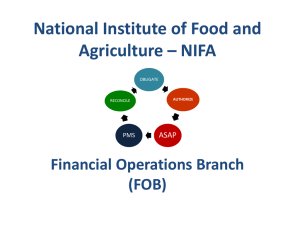“A New Song” Critical Race Theory (CRT)
advertisement
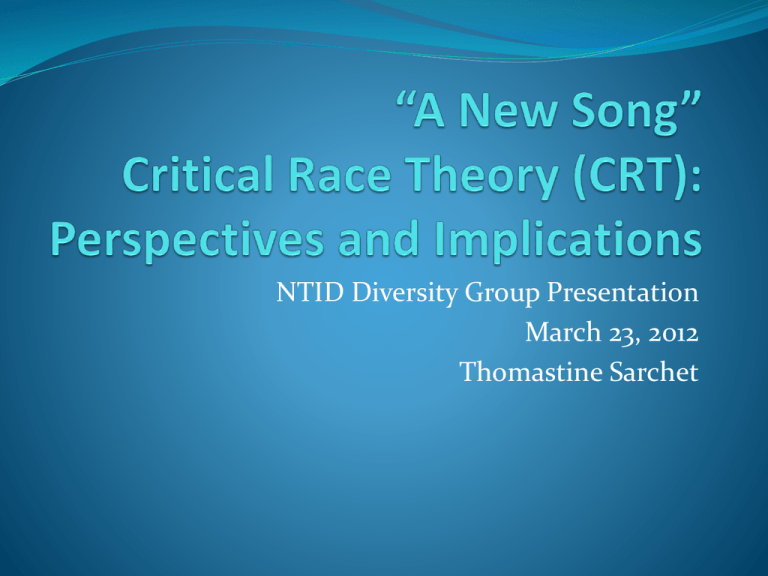
NTID Diversity Group Presentation March 23, 2012 Thomastine Sarchet Disclaimer By its very nature, the topic of critical race theory may be sensitive to people for a variety of reasons. The terminology, quotes, and examples used are not meant to harm, diminish, or offend anyone in any way. They are used purely for illustration and discussion purposes only. As we explore this topic together, I ask that we keep openness and respect for alternative perspectives at the forefront of our minds. Purpose To provide information and perhaps a “wake-up call” Ignite more conversation Ignite reflection and action = praxis (Freire) “ ‘[The aim… is critical consciousness] – learning to perceive social, political, and economic contradictions, and to take action against the oppressive elements of reality… [This begins with] reading the world. Reading the world always precedes reading the word, and reading the word implies continually reading the world… Both are necessary for critical consciousness and action, for understanding and changing the world.’ ” (Freire,1970, p. 17; Freire & Macedo, 1987, p. 35 as cited by Meuwissen, 2011). Relationship of CRT to other theories (Yosso, 2005, p. 71) How did we arrive at CRT? “The ‘new’ song of CRT was transposed from legal studies into the study of education in the mid-1990’s” (Dixson & Rousseau, 2006, p. 4). “Critical race theorists began to pull away from CLS because the critical legal framework restricted their ability to analyze racial injustice (Delgado, 1988; Crenshaw et al., 1995; Delgado & Stefancic, 2001; Crenshaw, 2002)” (Yosso, 2005, p. 72). Terms and Definitions Theoretical Lens “critical” Meta-narrative / Master Narrative Counter Narrative / Counterstorytelling Language Ownership Stereotype Threat Spokesperson Pressure Microaggression Tenets of CRT? Solorzano and Yosso (2001), proposed five themes: 1) the centrality of race and racism and their intersectionality with other forms of subordination 2) the challenge to dominant ideology 3) the commitment to social justice 4) the centrality of experiential knowledge 5) the transdisciplinary perspective (p. 472-473) Counter Storytelling “Critical race counterstorytelling is a method of recounting the experiences and perspectives of racially and socially marginalized people” “Counterstories seek to document the persistence of racism from the perspectives of those injured and victimized by its legacy” (Yosso, 2006, p. 11). Pulling the Pieces Together? 1. Centrality of race Social and Educational Reform Stereotype threat Microaggressions Counterstorytelling: Critical Analysis (theoretical lens): 3. Commitment to social justice 4. Experiential knowledge 5. transdisciplinary perspective 2. Challenge to the dominant ideology Criticisms of CRT “Fails to offer replacements for liberalism’s core values” (p. 789). “The race-crits are remarkably unhelpful as legal and political advocates within the liberal system…blamegame rhetoric does much to alienate potentially helpful whites” (p. 790). (Pyle, 1999) Criticisms of CRT “Has failed to meet the burden of proof of the existence of fundamental cognitive differences between subjugated and dominant voices that would warrant privileging the former over the latter in the research enterprise” (Farber and Sherry, 1995, as cited in Duncan, 2006, p. 201). Storytelling “fosters onesidedness and encourages a form of empathy that causes one to lose the distance and, by extension, the perspective necessary for judgment” (Duncan, 2006, p. 202). Sometimes Good Intentions. . . Critical Race Theory has been used to address a variety of issues in public education: Standardized Testing Affirmative Action First generation scholarships Social / emotional impacts on marginalized students (AALANA) Academic achievement “gap” and drop-out rates Using a CRT theoretical lens, how do you think this theory has addressed racial equality in schools? Why? Questions to puzzle over Have you ever felt “spokesperson pressure”? How did you respond? Is a verbal or physical act a “microaggression” or could it be an (unfounded?) suspicion? Where is the line between acknowledging a cultural norm or practice and stereotyping? Does language ownership influence microaggressions and stereotypes? Group Activity Read the scenario and discuss it in small groups. Talk about what you think is happening in the situation. Can you relate to it? or Have you experienced something similar? What would you do in this situation? Challenge Questions: Have you experienced (or witnessed) microaggressions here at RIT/NTID? What can we do as a community to address these issues? References Dixson, A. D. & Rousseau, C. K. (2006). Introduction. In A. D. Dixson & C. K. Rousseau (Eds.), Critical race theory in education: All god’s children got a song (pp. 1-8). New York: Routledge. Duncan, G. A. (2006). Critical race ethnography in education: Narrative, inequality, and the problem of epistemology. In A. D. Dixson & C. K. Rousseau (Eds.), Critical race theory in education: All god’s children got a song (pp. 191-212). New York: Routledge. Meuwissen, K. (2011, November 3). Critical pedagogy: Oppression, problem-posing, and the social institution of schooling. Powerpoint lecture presented in Dewey Hall room 1-305 on the University of Rochester campus. Pyle, J. J. (1999). Race, equality and the rule of law: Critical race theory's attack on the promises of liberalism. Boston College Law Review, 40 (3), 787-827. Solorzano D. G. & Yosso T. J. (2001). Critical race and LatCrit theory and method: Counter-storytelling Chicana and Chicano graduate school experiences. International Journal of Qualitative Studies in Education, 14 (4), 471-495. Yosso, T. (2005). Whose culture has capital? A critical race theory discussion of community cultural wealth. Race Ethnicity and Education, 8(1), 69-91. Yosso, T. J. (2006). Why use critical race theory and counterstorytelling to analyze the chicana/o educational pipeline? In Critical Race Counterstories Along the Chicana/Chicano Educational Pipleine (pp. 1-21). New York: Routledge.

